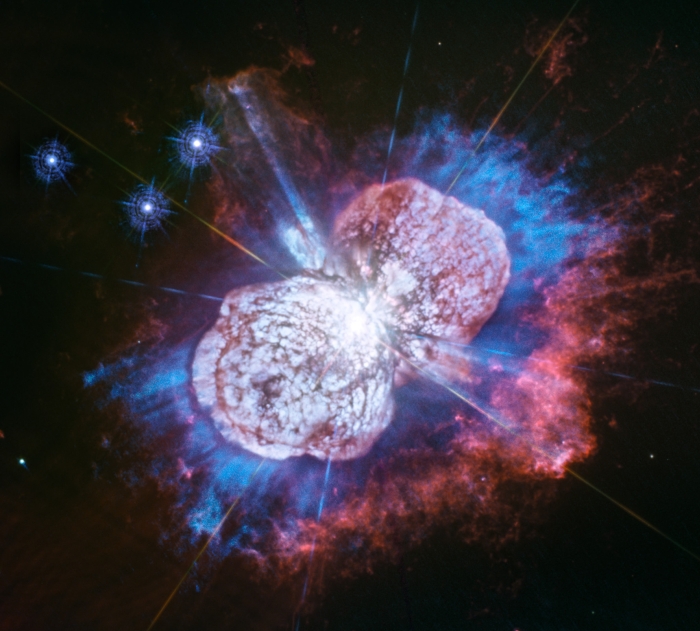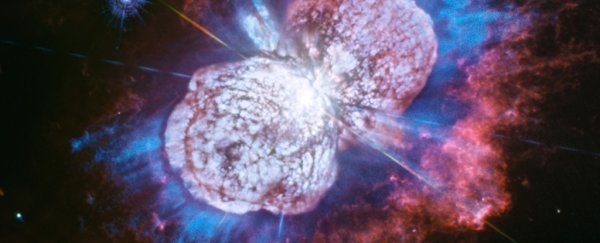The death of a binary star is not a peaceful affair. They rumble and erupt, blasting off their outer material and spewing radiation across the electromagnetic spectrum out into space.
It's a process that can take a very long time - the more massive the star, the more spectacular the firework display.
Eta Carinae, a binary star 7,500 light-years away, is indeed pretty massive. Its two stars clock in at 90 and 30 times the mass of the Sun.
So its no wonder that the pair's death throes are jaw-dropping - and they've been ongoing for nearly 200 years.
(Standard disclaimer - what we're seeing actually happened 7,500 years ago, but the radiation (light, X-rays, radio waves) is only reaching us now, so we refer to the events in the present tense.)
Eta Carinae erupted magnificently in 1838, in what is known as the Great Eruption. By April 1844, it was the second brightest object in the night sky. It blasted a bunch of material out into space, as much as 40 times the mass of the Sun, and that material surrounds the stars as the Homunculus Nebula.
The dying binary star has not done anything so dramatic since, but new images taken using the Hubble Space Telescope show that it's still active within the glowing cloud of its own corpse.
To capture the breathtaking new pictures, astronomers used the Wide Field Camera 3 instrument; their research goal was to map magnesium glowing in ultraviolet light.
The Homunculus Nebula has two lobes, or bubbles, of material blown outward; that's gas and dust to the extent of up to 40 times the mass of the Sun, ejected by the larger star. The research team was expecting to find magnesium all mixed up in the filaments of shock-heated nitrogen gas around the outside of the nebula, pictured in red.
They certainly weren't expecting to find it in the space between the nitrogen and the bubbles. But there it was. You can see it in the image below, shown in blue.
 (NASA, ESA, N. Smith/University of Arizona, J. Morse/BoldlyGo Institute)
(NASA, ESA, N. Smith/University of Arizona, J. Morse/BoldlyGo Institute)
"We've discovered a large amount of warm gas that was ejected in the Great Eruption but hasn't yet collided with the other material surrounding Eta Carinae," said astronomer Nathan Smith of the University of Arizona, lead investigator of the Hubble program.
"Most of the emission is located where we expected to find an empty cavity. This extra material is fast, and it 'ups the ante' in terms of the total energy of an already powerful stellar blast."
This means that, prior to the ejection of those glowing bubbles in the Great Eruption, the star was likely already losing material. We just couldn't see it before now, because it's not in a visible wavelength, and we weren't looking with the right instruments.
If you look at the blue region below the lower left bubble, you'll see something else that had never been seen before: streaks. This is from ultraviolet light emerging from the bubble while thicker regions of dust block some of it, which creates shadows. It's a bit like rays of sunlight streaming through the clouds, but on a much bigger scale.
It looks really beautiful. But it also shows that maybe there's stuff we've missed in a bunch of nebulas.
"We had used Hubble for decades to study Eta Carinae in visible and infrared light, and we thought we had a pretty full account of its ejected debris. But this new ultraviolet-light image looks astonishingly different, revealing gas we did not see in either visible-light or infrared images," Smith said.
"We're excited by the prospect that this type of ultraviolet magnesium emission may also expose previously hidden gas in other types of objects that eject material, such as protostars or other dying stars; and only Hubble can take these kinds of pictures."
Meanwhile, we have no idea when Eta Carinae is going to blow, since we can't actually see the stars inside the nebula to find out more about them. It could be tomorrow. It could be tens of thousands of years from now. But we hope humans will still be around to see it.
You can find the image in high-resolution here, including wallpaper-sized versions.
